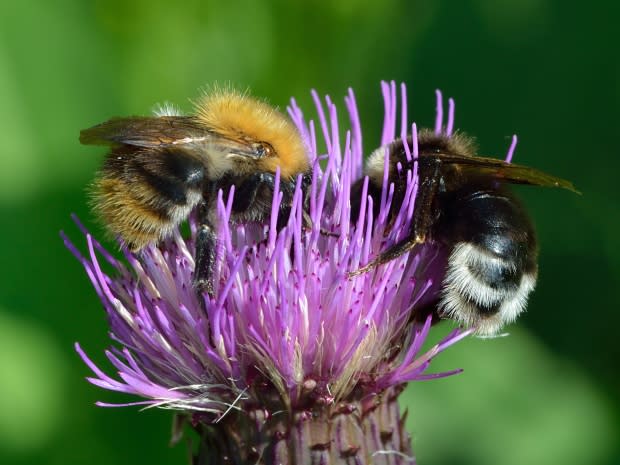City staff buzz about endangered bee discovery as boulevard preps for another season
A partnership between the City of Calgary, loads of nature-loving students and select universities is blooming into something exciting.
A so-called bee boulevard was created a couple of years ago on Canyon Meadows Drive, and this winter researchers identified an endangered pollinator frequenting the blooms.
David Misfeldt says the bee is called a gypsy cuckoo bumblebee — or bombus bohemicus.
"We didn't find just one, we found two, so that's a good sign," said the boulevard maintenance technician who dreamt up the idea of the pollinator-friendly corridor to help reduce road maintenance.
He helps maintain roughly 1,400 hectares of land for the city, and said Canyon Meadows boulevard "always looked bad."
"I call it unfunctional landscaping. The only purpose it serves is to try to survive," said Misfeldt. "I think we can do better than that."

Built with the help of 300 students, the bee corridor's goal is to attract all types of bees and butterflies and features native flowers, grasses and shrubs, as well as nesting habitats.⠀
"I went to each school and was expecting 10 to 12 of them from the eco club, but two schools sent their entire schools," said Misfeldt, adding they helped plant much of the butterfly-attracting milk thistle in the area.
"Kids are very interested in this. They know that bees and pollinators are very important to our survival. They get it."
The students were also treated to two talks: one from Alexandria Farmer who is helping design a bee-friendly campus where she works at Mount Royal University, and another from city parks ecologist Jenna Cross about Calgary's native plant.
Bee study underway in corridor
The city would later go on to partner with the David Suzuki Foundation, Sarah Johnson from Simon Fraser University to conduct field studies at the site and Lincoln Beat from the University of Calgary who identified the gypsy cuckoo bumble bee.
"When we started this project, I wanted it to have credibility behind it, and not just planting something again on the side of the road, or in the median, as a test plot," said Misfeldt. "I thought if I got universities involved and very smart bee people it would gain credibility."
Now Misfeldt says the researchers are studying how much the site is helping pollen-hungry species for five years.
He says there's lots of land across Calgary that could be converted into bee boulevards — and he hopes to see that happen in the future if city council approves.
"I think Calgary is really forward thinking on this," said Misfeldt, adding they've found 15 other bumble bee species on site and nearly 100 other native bee species.
There's also a bee nest, which he helped design in a flower shape near Acadia Drive S.E. and Canyon Meadows Drive S.E. It works as an information log where people can lift it up to see native bees hard at work. There's also a bee hotels, and bee boxes on site.

Bee death concerns
Gypsy cuckoo bumblebees used to be spread across Canada but have been on the decline over the last 30 years, being added to the endangered list in 2014. This year the species was only spotted in Calgary, northern Alberta and a small part of the Yukon.
A team of researchers at York University recently warned that the American bumblebee is facing imminent extinction from Canada, and this could lead to "cascading impacts" throughout the country.
About 42 of the more than 850 species of bees in Canada are bumblebees — important pollinators needed to grow crops, including apples, tomatoes, blueberries and legumes, as well as trees, shrubs and wildflowers — and many are exhibiting substantial declines.
Misfeldt said June 17-23 is national pollinator week, and he wants to challenge every restaurant in the city (and even across Canada) to make a "pollinator-friendly" menu to show just how important bees are to our food sources.
Other bee initiatives
Right now, Misfeldt says they are just seeding flowers to launch the third year of the bee corridor. He says the key to attracting good local pollinators is to plant native plants, something he says the experts at ALCLA Native Plant Restoration Inc. can help with if anyone else is interested in stepping up their bee game.
Misfeldt says other places, like the Phoenix Foundation School, are taking on big bee initiatives.
Or there's the Calgary Zoo, which has bee business status. Other schools — like the University of Calgary and Mount Royal University — are also looking for accreditation.
Calgary isn't the only municipality in the area looking to give struggling bees a boost.
The City of Airdrie was officially recognized as Canada's 23rd Bee City on April 15, following in the footsteps of Chestermere — which became the first one in Western Canada in 2016, and the second only to Toronto.
"Pollinators have been around for 125 million years and let's hope we can ensure they stay around for the next 125 million years," said Shelly Candel from Bee City Canada in an email.

